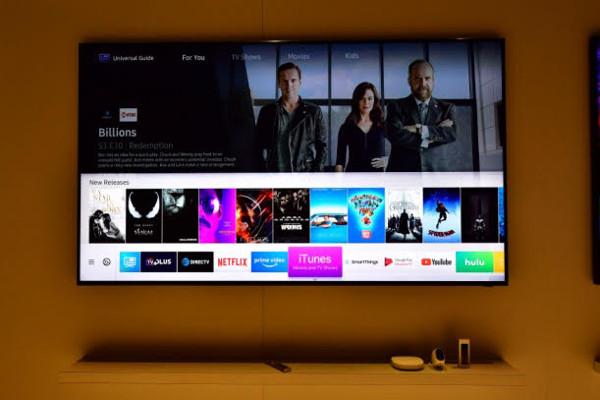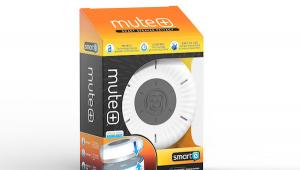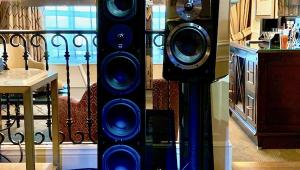Streaming, Voice Control Tech Abounds at CES 2019

Artificial Intelligence (AI) is taking voice control to a whole new level. The Roku TV and Google Android TV platforms are expanding to high-performance TV models. Content providers are looking to offer a one-stop shop as Plex joins the ranks of those offering premium channels and ad-supported movies to its aggregated media server. And Tablo announced a beefy Wi-Fi TV tuner that can skip commercials more efficiently.
There’s a lot going on in the space but the big news comes from an unlikely partnership of Samsung and Apple.
Samsung to Add iTunes and AirPlay
When you consider that Apple iPhones and Samsung Galaxy Android Phones have had a rocky, competitive, and litigious past, this partnership is surprising. Beginning this spring, Samsung TVs will offer an iTunes Movies and TV Shows app along with Apple AirPlay 2 support. What’s more, in addition to including Apple features in its 2019 TVs, Samsung will also make them available on its 2018 smart TVs via a firmware update.
The iTunes Movies and TV Shows app will initially be exclusive on Samsung TVs. The app allows users to rent, buy, or stream from their iTunes library. In the past year, iTunes upgraded many of its titles to 4K HDR so it’s reasonable to expect streaming via the native iTunes app on a high performing Samsung TV to be an excellent experience.
In recent years, Samsung has made it easy to stream directly from its Samsung Galaxy universe. The addition of AirPlay accommodates the many iPhone, iPad, and Mac users who will now be able to stream directly from their Apple devices to Samsung TVs. AirPlay 2 will be supported on the QLED 4K and 8K TVs, The Frame and Serif Lifestyle TVs, as well as other Samsung 4K/UHD and HD models.
AirPlay Comes to More TVs
Other TV manufacturers also announced the addition of Apple AirPlay to their 2019 TV lines. Both LG and Vizio will include AirPlay in their new TVs. Previous Vizio models supported GoogleCast, similar to Chromecast where a phone could cast content or be mirrored to the TV. AirPlay provides a similar experience for Apple users. 2019 TVs from LG, Vizio, and Samsung will support AirPlay 2, which enables Apple users to stream video and music from their iPhones, iPads, or Mac computers directly to the TV. Apple users will also be able to summon Siri (on their device) to find a title and play it on the TV. Mirroring the phone to the TV and displaying photos will also be supported.
Vizio claims it will be first to market with a TV that supports three voice platforms: Google Assistant, Amazon’s Alexa, and Apple’s Siri. Vizio may well be the first to launch but it won’t be the only company to offer all three voice-control options in 2019.
Android TVs to Add Amazon Alexa
While Android-based TVs from LG, Vizio, and Hisense already have Google Assistant control built-in, 2019 models from these brands will also include Alexa voice control. At its pre-CES press conference, LG explained that Alexa can be accessed on its new TVs with a long-press of the Amazon Prime Video button. “Just like with Google, Alexa users can manage smart home devices, ask questions, access tens of thousands of skills, and even set up their ideal Alexa Routine,” the company said. With both Google Assistant and Amazon Alexa onboard, these TVs will be able to control 84 percent of today’s connected home devices.
Full Google Assistant Features Come to Dish Hopper
Speaking of Google Assistant, Dish announced that the Google Assistant features added last year to its Dish Hopper set-top box/DVR will be expanded in 2019 to include full voice-control capabilities. Although Dish isn’t exhibiting at CES this year, Google is showing the updated Hopper at its booth.
With Google Assistant built-in, Dish owners will be able to use the Dish voice remote as they would with any Google Assistant-enabled speaker to control lights, thermostats, and other smart-home devices, get weather reports and ask questions. The Amazon Alexa skill for Dish only controls the Dish Hopper and cannot be used to control other devices.
Enabling Voice Control from Across the Room
While using voice commands via Google Assistant or Amazon Alexa to control your TV is convenient, voice control gets even better when you can speak the commands from across the room. Far-field microphones built into some 2019 TVs are always listening for a wake word so all you have to do is speak, no matter where you are in the room.
Samsung’s Bixby-enabled remote control also has integrated far-field microphones so you can activate voice without having to press a button — all you have to do is speak.
Samsung and LG Use AI to Improve Voice Control
At their CES press events, both Samsung and LG highlighted AI as it relates to voice control on their TVs. Samsung has incorporated AI into its proprietary voice control platform, Bixby. Thanks to AI, users can simply ask, “Show me TV shows like the one I was watching yesterday at this time” to get recommendations of similar shows. Bixby also asks intuitive questions to encourage sequential conversations that will enable it to better understand what the user has in mind. In the same way people get to know each other better over multiple conversations, Bixby learns more about a user’s preferences from each interaction, enabling the onboard AI to make informed suggestions about what to watch.
LG uses its ThinQ AI platform to enhance voice control with visuals. ThinQ makes visually-rich Alexa interactions possible when playing music, checking the weather, or accessing any of a number of skills. With the Food Network skill, for example, you can display recipes on the TV screen. Other examples include displaying shopping and to-do lists and enabling users to use the Kayak skill to book a flight onscreen. With AI, the TV knows what you are watching so when you ask a question like, “Who is the director of this movie?”, the answer is displayed in an overlay at the bottom of the screen.
Roku Finds its Way Into High End TVs
Until now, Roku TV has appeared on entry-level or value-priced TVs. And it makes sense that this easy-to-use operating system would be offered to tech-reticent users who don’t invest in high-end home theaters. But that’s about to change in 2019 because TV manufacturers have noticed that even discriminating TV viewers want to keep things simple.
Here at CES, TCL announced that a Roku-enabled 8K TV is under development. The TV will incorporate built-in far-field array microphones so it can pick up voice commands from across the room. Many of TCL’s other Roku TV models will also incorporate microphones that employ sophisticated noise suppression and beam-forming localization technologies to improve voice comprehension.
Hisense announced plans to release a mid-priced Roku-enabled TV in May, which will be followed up by the Hisense Roku TV R8 later in the year. The R8 will be offered in 55- and 65-inch screen sizes at $600 and $750, respectively. The company also hinted that Roku TV will show up in other models, including the H8F Roku TV and 75-inch U9F 4K TV ($3,500) announced earlier in the week. The U9F will first be available as an Android TV with the Roku TV version to be announced later this year.
Streaming Device News
Most of the streaming news coming out of this year’s CES was about TVs, as streaming devices are typically released at the end of the year before the holidays. One exception is the new Tablo Quad from Nuvyyo, maker of Tablo Wi-Fi-connected TV tuners and DVRs. Slated for release in early 2019 at $199, the Quad is a four-tuner DVR that works with an external USB hard drive or an internal SATA drive (with up to 8 terabytes of capacity) that can store up to 4,000 hours (166 days straight) of HD content recorded over the air.
Tablo also announced a new, more precise commercial skip feature that relies on sophisticated cloud-based algorithms and machine learning (instead of device power and visual cues) to improve skipping accuracy. The beta version is open to Tablo OTA DVR owners who have an active guide subscription ($4.99/month, $50/year, or a one-time fee of $150).
Plex in Talks to Add More Premium Content
Much of the streaming content news for 2019 was announced this past fall. Disney and AT&T/Time Warner revealed plans for a new streaming service and Facebook said it wants to offer subscriptions to premium services like HBO and Showtime through its app. According to CES news reports, Plex is also looking into premium services and ad-supported video that could be added to users’ libraries on the Plex media server in 2019. The idea is that users would be able to access movies, TV shows, and music from their libraries alongside content from other services — a move that has been likened to the Roku Channel’s free ad-supported streaming content and Amazon Prime’s Premium Channel subscription.
“The market is heading in this direction,” Plex CEO Keith Valory told TechCrunch. “People realize there are too many services, too many silos. There’s just too much. It’s just madness. So if there’s a way to get in front of these users — and do it in a way that they love — we want to be part of that.”
Indeed, CES 2019 shows the promise of fun new ways to interact with TVs and devices. I look forward to testing the latest devices and features in the New Year and reporting on the results.
- Log in or register to post comments






















































